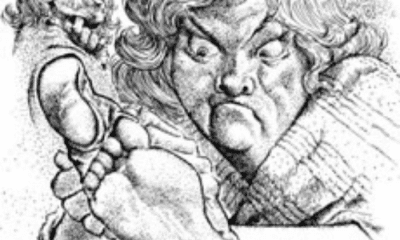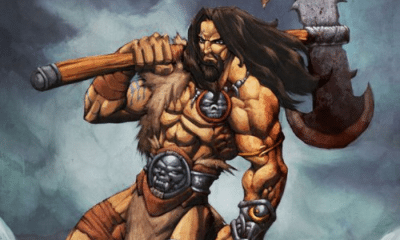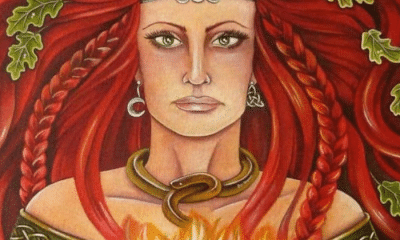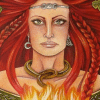Irish
Who Was Midir in Irish Mythology?
Midir was a legendary figure of Irish mythology who used magic and cunning to win the love of a beautiful princess.
Many Irish myths feature the Tuatha Dé Dannan, the god-like residents of the early Celtic world. After losing much of their power, many of the Tuatha Dé Dannan retreated underground and became what would later be called fairies.
One of these characters was Midir, a prince of the Tuatha Dé Dannan. Handsome and intelligent, he was a popular character in stories of the sidhe.
One of his most famous tales was of his love affair with a beautiful woman named Étain. Separated by magic, his love endured even as Étain was reborn into a second life with no memory of him.
Midir’s endless love of Étain led him to challenge one of Ireland’s mythical High Kings for her hand. He used cunning to win her and shapeshifting magic to carry her back to his underground fortress.
The origins of Midir and Étain’s love story are shrouded in mystery and span many eras of Irish history. From ancient archetypes through Christian retellings, the tale endured through its combination of love, magic, and history.
The Legend of Midir and Étain
In early Irish legends, Midir was a son of the Dagda. One of the Tuatha Dé Dannan, regarded as the gods of pre-Christian Ireland, the Dagda was a king and warrior who was also associated with magic and knowledge.
In another version of the story he is called a “son of Induí,” making him a relative of both the gods and the first kings of Ireland.
As one of the Dagda’s sons, Midir was considered for the position of king among the Tuatha Dé Dannan. He was passed over, however, in favor of Bodb Derg.
After the Tuatha Dé Dannan were defeated by human settlers, they retreated to the sidhe, their underground forts. Midir lived in the sidhe of Brí Léith.
Midir was usually described in terms of beauty and nobility. He wore a circlet of gold in his blond hair, carried a white shield encrusted with golden gems, and wore a tunic of rich purple.
Midir’s most famous story was that of his love affair with Étain, a beautiful princess.
Midir was married to Fúamnach, a witch of the Tuatha Dé Dannan, but fell in love with Étain, who various legends describe as the princess of the Uliad people or a daughter of a sidhe lord.
With the help of Aengus, who was either his foster son or half-brother, Midir won Étain’s love in return. They were not able to keep their affair a secret for long, however, and his wife soon learned that he had taken the princess as his new lover.
Fúamnach used her magic to transform Étain into a variety of forms and an attempt to get rid of her. She changed her into a dragonfly, water, and a worm before finally making her a fly who was blown away on a gust of wind.
Aengus recognized the fly, but could not reach Midir to tell him in time. When Fúamnach learned that Aengus was keeping Étain safe, she sent another wind that carried the fly for seven years.
As a fly, Étain fell into a glass of wine that was being drunk by a far-off queen. The queen swallowed the insect and Étain was reborn nine months later.
Étain grew as beautiful in her second life as she had been in her first, but retained no memories of Midir. Although he searched for her for years, he was not able to find his lover again until she had been married to Eochaidh, the High King of Ireland.
Although she did not remember Midir at first, she eventually came to know and love him once more. Her loyalty to Eochaidh, however, prevented her from leaving.
Determined to win her back, Midir appeared in the king’s court and challenged him to games of fidchell, a strategic board game similar to chess.
Eochaidh was a skilled player and won every match. He earned many rich prizes including fifty red horses, fifty swords with ivory hilts and fifty with gold, fifty three-headed rams, and a vat of strong wine.
Midir, however, won the final game. All he asked as his prize was a single kiss from Étain.
Eochaidh stipulated that Midir must wait a month to claim his prize, and when he returned to do so the king’s court was filled with armed soldiers. To reach Étain, Midir magically appeared at her side and transformed them both into swans to fly away.
The High King searched throughout Ireland for his missing wife. According to some stories, he destroyed every sidhe fort he came across until he found Midir’s home at Brí Léith.
Eochaidh began to dig his way into Brí Léith. Before he could reach it, however, Midir sent Étain out to meet him.
In fact, Midir sent fifty copies of Étain. He told the High King that if he could recognize his real wife he could keep her, but if not he would have to cease his war against the sidhe.
Two versions of the tale survive.
In one, Eochaidh failed in his task. He took his chosen bride home only to discover the next day that he had chosen his own daughter instead.
In the other, a magical bee settled on the real Étain’s shoulder, allowing her husband to recognize her. Eochaidh won his wife back from the sidhe lord and Midir was forced to end his quest for love.
My Modern Interpretation
The story of Midir and Étain contains many irregularities that give insight into Irish mythology through the years.
He is usually described as one of the Tuatha Dé Dannan. The Tuatha Dé Dannan stories, however, are said to have taken place many centuries before those of the high kings of Ireland.
While Midir was certainly thought of as long-lived, as evidenced by the fact that Étain grew into adulthood for a second time while he searched for her, he was not considered immortal. This means that it should have been impossible for him to have lived during the times of both the Tuatha Dé Dannan and Ireland’s human kings.
In Irish mythology, such inconsistencies can often be attributed to the limited source material now available to us.
Irish legends were not written until after the country had been Christianized. Christian monks wrote the stories of past beliefs, often leading to both inconsistent narratives and foreign interpretation by writers who did not worship the gods of pagan Ireland themselves.
In the case of Midir, however, evidence within the story suggests that his role was complex in pre-Christian versions of the story, as well.
Historians believe that Irish mythology references the many groups of people who settled the land through the ages. In the stories, these people constantly fight wars with one another until the final race, the Gaelic Milesians, prevail.
In this interpretation, the Tuatha Dé Dannan are not properly gods, but are deified ancestors of the Irish people. They represent an earlier group of people who settled Ireland before eventually being displaced by the Gaelic people who immigrate from Iberia.
The Tuatha Dé Dannan retreated into the sidhe below ground, leaving Ireland to be ruled by Gaelic kings. Stories of both their deities and their kings became legendary and the Tuatha Dé Dannan came to be seen as what English speakers today would call fairies.
It is likely, therefore, that the legend of Midir is older than the Gaelic people who passed it down.
The story of Midir and Étain could have been influenced by an actual event from pre-Gaelic Ireland in which two chieftains fought for the hand of the same woman. The story’s most fantastical elements were added as the characters from the legend came to be seen as more god-like than human.
Alternatively, the origins of the story may have predated the arrival of the Gaelic people.
Midir and Étain’s legend has many similarities with stories from other Indo-European religions. His transformation into a swan to steal her away, for example, is similar to stories from Greek and Norse mythology.
Rather than being a fantastical retelling of a historic event, therefore, the legend of Midir could be an ancient myth that was passed down even as its original culture died out.
This would explain some of the incongruities in the story. The timeline of events and relationships between certain characters are unclear because the story had been adapted to fit more than one set of beliefs.
The different versions of the ending almost certainly reflect the conflict between different sets of beliefs, however.
The Christian monks who wrote down the stories of Irish mythology did not themselves believe in the sidhe and the Tuatha Dé Dannan. They were surrounded, however, by people who did.
Even as Ireland became a Christian land, the stories of the sidhe remained popular. Well into the modern era, people in Ireland retained their belief in the fairy folk who lived underground.
The medieval Church in Ireland, as well as many other parts of Europe, constantly worked to eradicate these non-Christian beliefs, with mixed levels of success.
The version of the story in which Eochaidh won against Midir is likely an example of this effort to eradicate the sidhe from popular belief. Eochaidh destroyed many of their underground forts and outsmarted Midir, minimizing the power of the Tuatha Dé Dannan.
In Summary
Midir was a prince of the Tuatha Dé Dannan who moved into an underground sidhe in the age of Ireland’s High Kings. His most famous story involves his love affair with a beautiful woman named Étain.
When he fell in love with Étain, he was already married. His jealous wife turned Étain into a fly and had her carried hundreds of miles away on the wind.
Étain was eventually swallowed by a human queen and reborn as her daughter. She grew into adulthood again with no memory of her previous life and was married to Ireland’s High King by the time Midir found her again.
Their love was soon rekindled, but Étain could not leave her husband to be with Midir. The fae prince challenged the human king in a board game to win a single kiss.
When the king tried to keep Midir from claiming his prize, he magically appeared at Étain’s side. They both turned into swans and flew away together.
King Eochaidh dug up many of the underground sidhe forts before finding Midir’s stronghold. There he was told to choose from fifty copies of Étain, and versions of the story differ on whether or not he chose correctly.
The origins of Midir’s story are unclear. If, as many historians believe, the stories of the Tuatha Dé Dannan reference ancient events in pre-Gaelic Ireland, Midir and Eochaidh may have been based on warring chieftains.
The story also has many similarities to mythological love stories from other cultures, supporting the idea that it may have been an ancient tale that continued across cultures.
The Christian monks who eventually wrote down the stories of the Tuatha Dé Dannan had their own biases which were reflected in how they told the tale. The idea that Eochaidh prevailed and won back his bride after destroying the side forts is probably a Christian attempt to quell popular belief in the magical races of Irish mythology.









